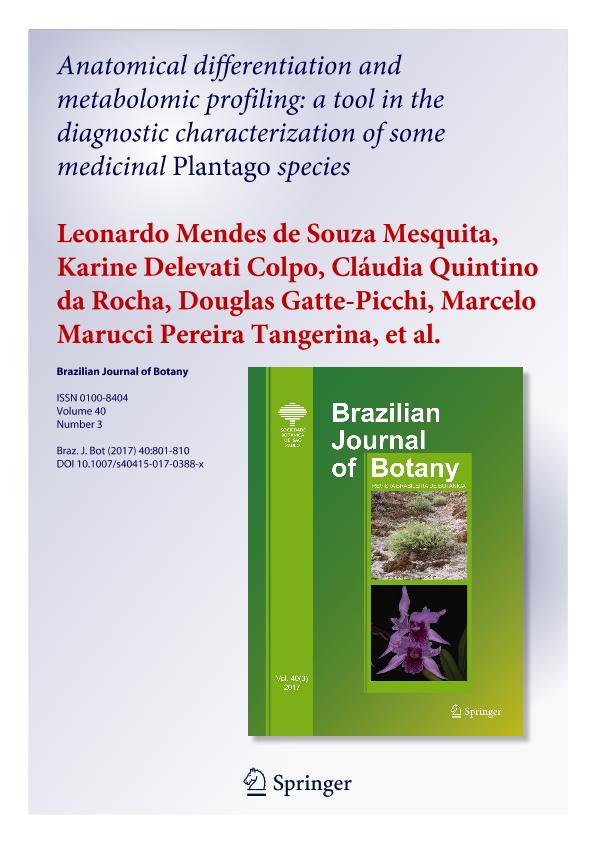Artículo
Anatomical differentiation and metabolomic profiling: a tool in the diagnostic characterization of some medicinal Plantago species
Mesquita, Leonardo Mendes de Souza; Delevati Colpo, Karine ; da Rocha, Cláudia Quintino; Gatte Picchi, Douglas; Pereira Tangerina, Marcelo Marucci; Zachello Nunes, Beatriz; Gonçalves Martins, Maria Bernadete; Vilegas, Wagner
; da Rocha, Cláudia Quintino; Gatte Picchi, Douglas; Pereira Tangerina, Marcelo Marucci; Zachello Nunes, Beatriz; Gonçalves Martins, Maria Bernadete; Vilegas, Wagner
 ; da Rocha, Cláudia Quintino; Gatte Picchi, Douglas; Pereira Tangerina, Marcelo Marucci; Zachello Nunes, Beatriz; Gonçalves Martins, Maria Bernadete; Vilegas, Wagner
; da Rocha, Cláudia Quintino; Gatte Picchi, Douglas; Pereira Tangerina, Marcelo Marucci; Zachello Nunes, Beatriz; Gonçalves Martins, Maria Bernadete; Vilegas, Wagner
Fecha de publicación:
09/2017
Editorial:
Sociedade de Botânica do Brasil
Revista:
Revista Brasileira de Botanica
ISSN:
1806-9959
Idioma:
Inglés
Tipo de recurso:
Artículo publicado
Clasificación temática:
Resumen
There is a large list of plants used by the population as medicine, but in some case the choice of the right plant becomes a real drawback in phytotherapy, since it is often difficult to differentiate morphologically between the active and inactive species. Plantago species are widely used throughout the world as analgesic, anti-inflammatory, expectorant, digestive and wound healing. Nonetheless, Plantago spp. share very strong morphological similarities, which hinders their correct botanical identification and, in addition, they are equivocally marketed by the same common name “Plantain”. Therefore, the establishment of a reliable approach to distinguish unambiguously closely related species arises as an important task in the development of herbal medicines. In this work, we report a method that combines anatomical leaf features and chemical composition of four Plantago species to generate a multivariate model, which allows the differentiation of these species. Descriptive leaf anatomy was converted into a binary matrix to create a qualitative/quantitative non-metric multidimensional scaling (nmMDS) based on Jaccard index. The main results show that P. lanceolata L. is the most distinct species, the only one that owns mesophyll isolateral, colateral vascular bundle and a glandular trichome with spindle cells. Plantago major L. also has a unique glandular trichome, with enlarged basal cell and collar cell. This statistical-based anatomical approach is suitable to solve similar drawbacks in plant medicines of any other plant-cases. In addition, it was generated a nmMDS to chemical markers by mass spectrometry (FIA–ESI–IT–MS), to define how similar the species are regarding their chemical composition. Plantago major showed all compounds evaluated and is the only species to have the compounds hellicoside (m/z 655) and lavandulifolioside (m/z 755). The conversion of anatomical features into statistical data with the chemical composition emerges as a useful approach toward the quantitative differentiation of morphologically close related specimens.
Palabras clave:
Leaf Anatomy
,
Mass Spectrometry
,
Multivariate Analyses
,
Plantain
,
Thricome
Archivos asociados
Licencia
Identificadores
Colecciones
Articulos(ILPLA)
Articulos de INST.DE LIMNOLOGIA "DR. RAUL A. RINGUELET"
Articulos de INST.DE LIMNOLOGIA "DR. RAUL A. RINGUELET"
Citación
Mesquita, Leonardo Mendes de Souza; Delevati Colpo, Karine; da Rocha, Cláudia Quintino; Gatte Picchi, Douglas; Pereira Tangerina, Marcelo Marucci; et al.; Anatomical differentiation and metabolomic profiling: a tool in the diagnostic characterization of some medicinal Plantago species; Sociedade de Botânica do Brasil; Revista Brasileira de Botanica; 40; 3; 9-2017; 801-810
Compartir
Altmétricas



